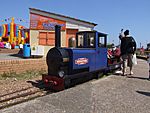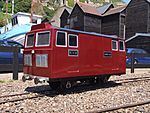Hastings Miniature Railway facts for kids
Quick facts for kids Hastings Miniature Railway |
|
|---|---|

The eastern terminus, Rock-a-Nore, with a train in the station in 2011.
|
|
| Locale | Hastings, East Sussex, England |
| Preserved operations | |
| Preserved gauge | 10 1⁄4 in (260 mm) |
| Commercial history | |
| Opened | 1948 |
The Hastings Miniature Railway is a fun, small railway right on the seafront in Hastings, East Sussex, England. It's a "miniature railway" because its tracks are only about 10.25 inches wide! This popular tourist spot first opened in 1948. In 2011, the railway got a big makeover and reopened. This happened while a new art gallery was being built nearby.
Contents
History of the Hastings Miniature Railway
The story of the Hastings Miniature Railway began with Captain J.E.P. Howey. He was a railway enthusiast who owned the Romney, Hythe and Dymchurch Railway. Captain Howey loved miniature trains and collected several of them.
One of his trains was a small 10.25-inch gauge model. It was a Great Western Railway "pannier tank" engine. This means it had water tanks on the sides, like panniers on a horse. Howey rebuilt this engine into a tender locomotive named 'Firefly'. He also got a model of a Royal Scot engine.
These small trains were too narrow for Howey's main railway. But they did run for a short time after World War II. They ran on a special track near New Romney. They also operated near Dymchurch until 1947.
Later, the trains moved to St Leonards-on-Sea. Captain Howey ran a small railway there for less than a year. Because of local complaints, the railway moved to Hastings. It was then sold to Ian Allan and Jim Hughes. This was the start of the Hastings Miniature Railway, which opened in 1948.
Stations on the Line
The Hastings Miniature Railway has three main stations. Each one has its own unique features.
Rock-a-Nore Station
Rock-a-Nore Station is the main hub of the railway. It started with one platform and later had two. Now, it has returned to a single platform. A special turning platform for trains, called a turntable, was added around 1960. It was removed around 1980 but restored in 2011.
This station has always had a building, engine shed, and carriage shed. Since 2011, it also has a modern workshop for repairs. Rock-a-Nore is in the fishing part of Hastings. You can see fishing boats and net houses nearby.
East Beach Street Station
East Beach Street Station was the first end point of the railway from 1948 to 1959. It was also known as 'East Beach Station'. It had two platforms and a station building. When the railway was made longer in 1959, it became a through station.
Signals were added so two trains could run at once. The station closed around 1970. In 2010, a "passing loop" was put back. This allows trains to pass each other again. One platform is still there. This station is on the beach, close to the lifeboat station.
Marine Parade Station
Marine Parade Station has been the western end of the railway since 1959. It has one platform, a large station building, and a ticket office. There's also a "run-round loop" for engines to change ends.
This station is in the busy tourist area of Hastings. It's surrounded by hotels, fun attractions, and restaurants. In 2012, the tracks were replaced. A short siding was also added for parking locomotives.
Railway Operations: 1948 to 1984
The railway's main office and engine sheds were built in 1948 at Rock-a-Nore. This area of old Hastings is known for its fishing industry. The railway ran from here along the beach, called 'The Stade'. It went to a station near the lifeboat station. This station had a few different names over the years.
In 1959, the railway was made longer. It reached a new station at Marine Parade. This made the whole line a little over 600 yards long. The original station, East Beach Street, stayed open. It allowed two trains to pass each other. Rock-a-Nore station had one platform and a waiting shelter. It also had sheds for engines and carriages. A second platform was added later. A turntable was installed around 1960.
The railway used small steam locomotives. 'Firefly' was the most famous and ran for a long time. Later, diesel locomotives also started running. The most well-known diesel was 'Uncle Jim'. These two trains often ran the regular service. They were even shown on the railway's advertising signs.
In 1984, the railway got new owners. From then on, only diesel locomotives were used.
Famous Former Locomotives
Many interesting locomotives have run on the Hastings Miniature Railway.
- Firefly: This engine was built in 1936. It was rebuilt in 1945. 'Firefly' is very famous at Hastings. It ran from the railway's opening in 1948 until 1984. Then it was sold to the Kerr's Miniature Railway in Scotland. It still runs there today!
- Royal Scot: Built in 1938, this was a model of the LMS Royal Scot Class 6100 Royal Scot. Captain Howey bought it in 1947. This engine ran at Hastings from 1948 until 1975. It later moved to the Oakhill Manor Railway. After going to the USA, it came back to England in 2002. Now, it runs at the Royal Victoria Railway.
- Hampton Court: This engine was built in 1939. It ran on several other railways before coming to Hastings in 1958. It was rebuilt here as a Saint Class engine. 'Hampton Court' was sold in 1974. It now runs at the Stapleford Miniature Railway.
- Uncle Jim: Built in 1968, 'Uncle Jim' was a diesel engine. It ran from 1968 to 1993. This was the first engine built at Hastings. It had different paint colors over the years. Diesel engines were simpler to operate than steam trains. 'Uncle Jim' later ran at Knebworth Park Miniature Railway. In 2012, it returned to Hastings. After a full repair, it is now running again on its original railway.
- Western Meteor: This diesel locomotive ran on the railway from 1979 to 1982.
- MIS-NAT: This was a unique diesel engine. It ran from 1984 to 1990. Locals called it the 'Mecano engine' because it looked like it was made from spare parts. It was later used at other railways. In 2013, it was loaned back to Hastings. It was changed to look like a steam engine.
Sometimes, other locomotives would visit the railway. 'Victoria', a model of a LMS Jubilee Class engine, ran trains for one weekend in 1978. This was when the diesel 'Uncle Jim' was officially named.
Railway Operations: Since 1984
In the 1980s, the railway faced some tough times. Tracks at Rock-a-Nore were removed or became overgrown. The facilities looked a bit worn out.
In 1992, the owner removed most of the old East Beach Station. Only one platform remains. The passing loop was also removed, meaning only one train could run at a time. The old trains were sold. A new diesel locomotive that looked like a steam train, named 'Swee' Pea', was bought.
In 2008, the railway's passenger carriages were repainted. They all got the same color scheme and a new railway logo. There were eleven carriages available for passengers. The 'Swee' Pea' locomotive was also rebuilt to have a smoother design.
In January 2010, the railway got new owners. They were given a new lease to run the railway. But they had to make big improvements.
In August 2010, the railway officially reopened after a lot of rebuilding. Two new locomotives were added. Work also began on a fourth engine. 'Swee' Pea' was repainted black. The carriages were rebuilt with new bodies. Now, the railway has two full sets of carriages. This means two trains can run at busy times. The passing loop at East Beach Station was restored. In 2010, two trains passed each other there for the first time in 21 years!
In early 2011, a lot of work was done at Rock-a-Nore Station. It looks much better now. Many of its original features were brought back. The turntable was put back in place. The old engine shed was used again. A new workshop was built, and the platform was made longer.
In early 2012, similar work happened at Marine Parade Station. All the tracks were replaced. A new short track was added for parking locomotives.
In April 2012, the railway won the "Railway of the Year" award. This was given by the Ten and a Quarter Inch Gauge Railway Society.
Current Locomotives
The railway's current locomotives have a numbering system. It was started in 2011 by the new owners, Dan Radcliffe and David Miller. The numbers show the order in which the trains arrived (or returned) to Hastings. It doesn't mean how old they are or how long they've been running.
| Number | Name | Locomotive type | Wheel arrangement |
Builder | Built | Photo | Notes |
|---|---|---|---|---|---|---|---|
| 1 | Princess Swee' Pea | Steam-outline diesel | 0-6-0DH | Alan Keef Engineering / RVM Engineering | Chassis (AKL)1990 Body,Tender and Mechanical (RVM) 2012 |  |
Originally built by Alan Keef Ltd. Only the front chassis and smokebox remain from the original. |
| 2 | Jerry Lee | Diesel hydraulic | 4w-4w DH | RVM Engineering | 2011 |  |
Built at the railway using parts from an old locomotive body. |
| 3 | Firefly | Steam | 0-4-0T | Bob Yates | 1991 | Arrived at Hastings in 2010. It is waiting to be rebuilt as a diesel locomotive that looks like a steam engine. | |
| 4 | Speedy Fizzle | Diesel Hydraulic | 4w-4w DH | RVM Engineering | 2010-2011 |  |
Built at the railway in memory of engineer Daryl Mark Valentine. |
| 5 | Uncle Jim | Diesel Hydraulic | 4-4w DH | Jim Hughes | 1968 | Built at the railway in 1968. It ran from 1968 to 1989 and was sold in 1993. In 2012, it came back to Hastings. After a full repair, it is now running again on its original railway. | |
| 6 | Sir Duke | Diesel Hydraulic | 4-4w DH | 1984 | Built at the railway in 1984 as Mis-Nat. It was sold in 1993. In 2013, it returned to Hastings. After a full repair and a new name, it is running again on its original railway. | ||
| 7 | Tilby | Diesel Mechanical | 0-4-0DM | RVM Engineering | 2013 | Built at the railway from many different spare parts. It was made to look like a steam tram and has a face like Toby the tram. | |
| 8 | Thunderbolt III | Diesel Hydraulic | This locomotive is currently undergoing rebuilding work at Hastings (as of January 2018). |

